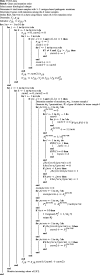Progression inference for somatic mutations in cancer
- PMID: 28492066
- PMCID: PMC5415494
- DOI: 10.1016/j.heliyon.2017.e00277
Progression inference for somatic mutations in cancer
Abstract
Computational methods were employed to determine progression inference of genomic alterations in commonly occurring cancers. Using cross-sectional TCGA data, we computed evolutionary trajectories involving selectivity relationships among pairs of gene-specific genomic alterations such as somatic mutations, deletions, amplifications, downregulation, and upregulation among the top 20 driver genes associated with each cancer. Results indicate that the majority of hierarchies involved TP53, PIK3CA, ERBB2, APC, KRAS, EGFR, IDH1, VHL, etc. Research into the order and accumulation of genomic alterations among cancer driver genes will ever-increase as the costs of nextgen sequencing subside, and personalized/precision medicine incorporates whole-genome scans into the diagnosis and treatment of cancer.
Keywords: Cancer research; Computational biology; Genetics; Oncology.
Figures























Similar articles
-
Driver gene alterations profiling of Chinese non-small cell lung cancer and the effects of co-occurring alterations on immunotherapy.Cancer Med. 2021 Oct;10(20):7360-7372. doi: 10.1002/cam4.4178. Epub 2021 Oct 2. Cancer Med. 2021. PMID: 34599863 Free PMC article.
-
Comprehensive genomic profiling of Brazilian non-small cell lung cancer patients (GBOT 0118/LACOG0418).Thorac Cancer. 2021 Mar;12(5):580-587. doi: 10.1111/1759-7714.13777. Epub 2020 Dec 13. Thorac Cancer. 2021. PMID: 33314759 Free PMC article.
-
Malignancy of Cancers and Synthetic Lethal Interactions Associated With Mutations of Cancer Driver Genes.Medicine (Baltimore). 2016 Feb;95(8):e2697. doi: 10.1097/MD.0000000000002697. Medicine (Baltimore). 2016. PMID: 26937901 Free PMC article.
-
Precision oncology of lung cancer: genetic and genomic differences in Chinese population.NPJ Precis Oncol. 2019 May 3;3:14. doi: 10.1038/s41698-019-0086-1. eCollection 2019. NPJ Precis Oncol. 2019. PMID: 31069257 Free PMC article. Review.
-
Advances in computational approaches for prioritizing driver mutations and significantly mutated genes in cancer genomes.Brief Bioinform. 2016 Jul;17(4):642-56. doi: 10.1093/bib/bbv068. Epub 2015 Aug 24. Brief Bioinform. 2016. PMID: 26307061 Free PMC article. Review.
Cited by
-
Integrative analysis of mutated genes and mutational processes reveals novel mutational biomarkers in colorectal cancer.BMC Bioinformatics. 2022 Apr 19;23(1):138. doi: 10.1186/s12859-022-04652-8. BMC Bioinformatics. 2022. PMID: 35439935 Free PMC article.
-
HyperHMM: efficient inference of evolutionary and progressive dynamics on hypercubic transition graphs.Bioinformatics. 2023 Jan 1;39(1):btac803. doi: 10.1093/bioinformatics/btac803. Bioinformatics. 2023. PMID: 36511587 Free PMC article.
-
HyperTraPS-CT: Inference and prediction for accumulation pathways with flexible data and model structures.PLoS Comput Biol. 2024 Sep 4;20(9):e1012393. doi: 10.1371/journal.pcbi.1012393. eCollection 2024 Sep. PLoS Comput Biol. 2024. PMID: 39231165 Free PMC article.
-
DNA Repair Gene Expression Adjusted by the PCNA Metagene Predicts Survival in Multiple Cancers.Cancers (Basel). 2019 Apr 8;11(4):501. doi: 10.3390/cancers11040501. Cancers (Basel). 2019. PMID: 30965671 Free PMC article.
References
LinkOut - more resources
Full Text Sources
Other Literature Sources
Research Materials
Miscellaneous

